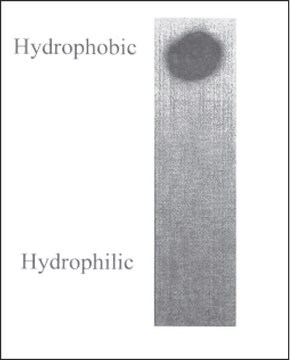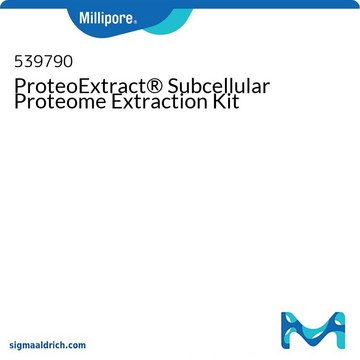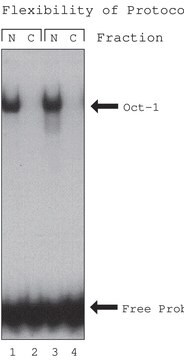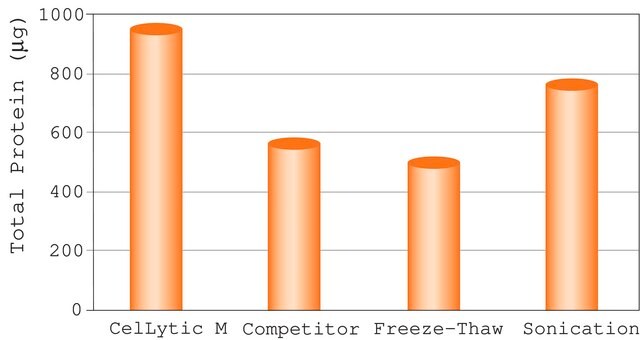444810
ProteoExtract® Native Membrane Protein Extraction Kit
Synonim(y):
Membrane protein extraction kit
Zaloguj sięWyświetlanie cen organizacyjnych i kontraktowych
About This Item
Kod UNSPSC:
41106500
NACRES:
NA.77
Polecane produkty
zastosowanie
sufficient for 20 extractions
producent / nazwa handlowa
Calbiochem®
warunki przechowywania
OK to freeze
metody
protein extraction: suitable
moc wejściowa
sample type: mammalian tissue
Warunki transportu
ambient
temp. przechowywania
2-8°C
Opis ogólny
A convenient kit for the isolation of native integral membrane and membrane-associated proteins, without the need for ultracentrifugation. Extraction is based on association of proteins with cellular membranes rather than on their hydrophobicity. Resulting samples are suitable for use in functional assays, 2-D gel electrophoresis, and other applications.
Membrane proteins represent only one-third of the proteins encoded by the human genome, but they represent more than two-thirds of the known protein targets for drugs. Therefore, approaches to prepare and characterize membrane proteins are of significant interest for drug discovery. However, due to their hydrophobic nature, membrane proteins are more difficult to analyze than soluble proteins. In addition to the intrinsic difficulty of solubilization, membrane proteins are challenging because of their general low abundance. Thus, the challenges for sample preparation of membrane proteins are effective solubilization and selective enrichment, ideally keeping proteins in a non-denatured state.
Note: 1 kit is sufficient for up to 20 sample extractions.
Komponenty
Wash Buffer, Extraction Buffer 1, Extraction Buffer 2, Protease Inhibitor Cocktail, and a user protocol.
Ostrzeżenie
Toxicity: Multiple Toxicity Values, refer to MSDS (O)
Zasada
The ProteoExtract® Native Membrane Protein Extraction Kit is designed for the isolation of native membrane proteins from a broad range of mammalian samples, including:
• Adherent tissue culture cells
• Suspension grown tissue culture cells
• Frozen cell pellets
• Tissues
• Adherent tissue culture cells
• Suspension grown tissue culture cells
• Frozen cell pellets
• Tissues
Uwaga dotycząca przygotowania
The amount of buffer required for each extraction is dependent upon the amount of starting cell material.
Przechowywanie i stabilność
• Wash Buffer
Store at 4°C.
• Extraction Buffers I & II
The Extraction Buffers I and II can be stored at 4°C for up to 6 month.
For prolonged storage, freeze the buffers in convenient aliquots at -20°C. Before extraction, buffers must be thawed at room temperature (RT). After thawing, mix components by gently shaking or vortexing. Avoid repeated freezing and thawing!
• Protease Inhibitor Cocktail
The Protease Inhibitor Cocktail is supplied in DMSO and can be stored at 4°C up to 6 months. For prolonged storage, freeze the cocktail in convenient aliquots at -20°C. During the sample preparation procedure it must be kept at RT to prevent freezing of DMSO.
Store at 4°C.
• Extraction Buffers I & II
The Extraction Buffers I and II can be stored at 4°C for up to 6 month.
For prolonged storage, freeze the buffers in convenient aliquots at -20°C. Before extraction, buffers must be thawed at room temperature (RT). After thawing, mix components by gently shaking or vortexing. Avoid repeated freezing and thawing!
• Protease Inhibitor Cocktail
The Protease Inhibitor Cocktail is supplied in DMSO and can be stored at 4°C up to 6 months. For prolonged storage, freeze the cocktail in convenient aliquots at -20°C. During the sample preparation procedure it must be kept at RT to prevent freezing of DMSO.
Informacje prawne
CALBIOCHEM is a registered trademark of Merck KGaA, Darmstadt, Germany
PROTEOEXTRACT is a registered trademark of Merck KGaA, Darmstadt, Germany
Ta strona może zawierać tekst przetłumaczony maszynowo.
Hasło ostrzegawcze
Warning
Zwroty wskazujące rodzaj zagrożenia
Zwroty wskazujące środki ostrożności
Klasyfikacja zagrożeń
Aquatic Chronic 3 - Eye Irrit. 2 - Skin Irrit. 2
Kod klasy składowania
10 - Combustible liquids
Certyfikaty analizy (CoA)
Poszukaj Certyfikaty analizy (CoA), wpisując numer partii/serii produktów. Numery serii i partii można znaleźć na etykiecie produktu po słowach „seria” lub „partia”.
Masz już ten produkt?
Dokumenty związane z niedawno zakupionymi produktami zostały zamieszczone w Bibliotece dokumentów.
Wenlu Li et al.
Journal of cerebral blood flow and metabolism : official journal of the International Society of Cerebral Blood Flow and Metabolism, 39(10), 2048-2060 (2018-05-23)
Blood-brain barrier (BBB) disruption in neurological disorders remains an intractable problem with limited therapeutic options. Here, we investigate whether the endothelial cell membrane protein annexin A2 (ANXA2) may play a role in reducing trans-endothelial permeability and maintaining cerebrovascular integrity after
Meenakshi Upreti et al.
Journal of molecular medicine (Berlin, Germany), 91(4), 497-506 (2012-10-24)
The present study reports on a new strategy for selective, radiation therapy-amplified drug delivery using an antiangiogenic 33-a.a., tumor vasculature-targeting ligand, anginex, to improve the therapeutic ratio for strategies developed against solid tumors. Our findings indicate that galectin-1 is (a)
Robyn T Sussman et al.
Frontiers in oncology, 10, 302-302 (2020-03-27)
We developed a computational pipeline designed to use RNA sequencing (n = 136) and gene expression profiling (n = 250) data from neuroblastoma tumors to identify cell surface proteins predicted to be highly expressed in MYCN amplified neuroblastomas and with
Jacqueline Bezençon et al.
Journal of pharmaceutical sciences, 110(1), 404-411 (2020-10-16)
Recent studies have focused on coproporphyrin (CP)-I and CP-III (CPs) as endogenous biomarkers for organic anion transporting polypeptides (OATPs). Previous data showed that CPs are also substrates of multidrug resistance-associated protein (MRP/Mrp) 2 and 3. This study was designed to
Masamitsu Shimazawa et al.
Journal of neurochemistry, 107(1), 279-290 (2008-08-12)
Here, we examined whether amyloid-beta (Abeta) protein participates in cell death and retinal function using three types of transgenic (Tg) mice in vivo [human mutant amyloid precursor protein (APP) Tg (Tg 2576) mice, mutant presenilin-1 (PS-1) knock-in mice, and APP/PS-1
Nasz zespół naukowców ma doświadczenie we wszystkich obszarach badań, w tym w naukach przyrodniczych, materiałoznawstwie, syntezie chemicznej, chromatografii, analityce i wielu innych dziedzinach.
Skontaktuj się z zespołem ds. pomocy technicznej









